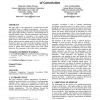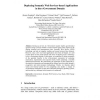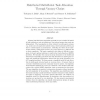375 search results - page 72 / 75 » A Cooperation Model for Teaching Learning Modeling Disciplin... |
GECCO
2005
Springer
14 years 1 months ago
2005
Springer
This paper offers a novel approach to coevolution based on the sociological theory of symbolic interactionism. It provides a multi-agent computational model along with experimenta...
JODS
2008
13 years 7 months ago
2008
Joining up services in e-Government usually implies governmental agencies acting in concert without a central control regime. This requires to the sharing scattered and heterogeneo...
CORR
2011
Springer
13 years 2 months ago
2011
Springer
Modeling the behavior of imperfect agents from a small number of observations is a difficult, but important task. In the singleagent decision-theoretic setting, inverse optimal co...
ICONFERENCE
2011
13 years 2 months ago
2011
To develop a science of small-group interaction in groupware, we need a method for analyzing the structure of computer-mediated discourse. Conversation analysis offers an analysis...
ICRA
2003
IEEE
14 years 1 months ago
2003
IEEE
Existing task allocation algorithms generally do not consider the effects of task interaction, such as interference, but instead assume that tasks are independent. That assumptio...



